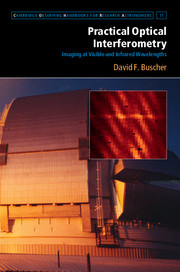Book contents
- Frontmatter
- Contents
- Principal symbols, functions and operators
- List of abbreviations
- Foreword
- Preface
- 1 Making fringes
- 2 Basic imaging
- 3 Atmospheric seeing and its amelioration
- 4 Interferometers in practice
- 5 Measurement noise
- 6 Interferometric observation of faint objects
- 7 Observation planning
- 8 Data reduction
- 9 Model fitting and image reconstruction
- Appendix A Fourier transforms
- Appendix B Supplementary online material
- References
- Index
5 - Measurement noise
Published online by Cambridge University Press: 05 August 2015
- Frontmatter
- Contents
- Principal symbols, functions and operators
- List of abbreviations
- Foreword
- Preface
- 1 Making fringes
- 2 Basic imaging
- 3 Atmospheric seeing and its amelioration
- 4 Interferometers in practice
- 5 Measurement noise
- 6 Interferometric observation of faint objects
- 7 Observation planning
- 8 Data reduction
- 9 Model fitting and image reconstruction
- Appendix A Fourier transforms
- Appendix B Supplementary online material
- References
- Index
Summary
Fringe visibility measurements and derived observables such as the power spectrum and bispectrum are subject to both systematic and random errors. Chapter 3 showed how a systematic reduction in the fringe contrast can arise from the effects of atmospheric seeing. This chapter concentrates on the main sources of random errors or noise.
Noise on fringe parameters can arise both from the effects of atmospheric seeing and also from noise sources associated with measuring the light intensity levels in the fringe pattern. The main aim of this chapter is to derive robust ‘rule-of-thumb’ estimates for the noise levels in a given observation. These rules of thumb can then be used to determine which noise sources are dominant and whether random errors or systematic errors provide the fundamental limitation to accuracy in any given case.
Atmospheric noise
5.1.1 Power spectrum
As discussed in Chapter 3, the spatial and temporal wavefront phase fluctuations which occur due to atmospheric seeing cause the mean fringe contrast to decrease as the apertures go from being point-like to being comparable in size to the Fried parameter of the seeing r0, and as the exposure times go from being infinitesimal to being comparable to the coherence time of seeing t0. Under these conditions the fringe contrast will also fluctuate on an exposureto-exposure basis. Exposure times and aperture sizes need to be as large as possible in order to get more light, so it is helpful to be able to quantify what the trade-off between these experimental variables and the atmospheric noise level is.
An idea for how the noise varies as a function of integration time can be obtained using the ‘random-walk’ model for the visibility reduction used in Section 3.3.2. In this model, the coherent flux is given by a random walk consisting of n steps so that
where F0 is the coherent flux in a single ‘step’ and Φk is the fringe phase at step k. The mean power spectrum is therefore given by
- Type
- Chapter
- Information
- Practical Optical InterferometryImaging at Visible and Infrared Wavelengths, pp. 129 - 151Publisher: Cambridge University PressPrint publication year: 2015



